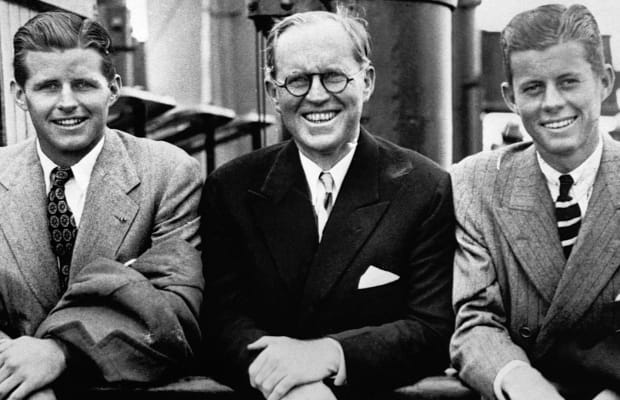JFK: Volume 1: 1917-1956
by Frederik Logevall (Viking, £16.99)
Felix M. Larkin
John Fitzgerald Kennedy’s reputation has held up remarkably well in the 60 years since he was elected president of the United States. In the polls that US historians periodically carry out to rank their presidents, his place has settled just inside the top ten – for example, No.8 in the authoritative C-SPAN Presidential Historians Survey in 2017. He was a president of consequence.
There are, however, only a few really good books – disinterested studies – among the many that have been written about him and his administration. The best to date are Robert Dallek’s biography, John F. Kennedy: an unfinished life, 1917-1963, published in 2003, and Richard Reeves’s President Kennedy: profile of power, published 10 years earlier. This study by Frederik Logevall, a Harvard University professor, joins that elite company.
It is volume one of what will be a two-volume biography, and it takes the story of Kennedy’s life up to his failed attempt to secure the vice-presidential nomination of the Democratic Party in 1956. The Democratic candidate for president that year was Adlai Stevenson, and he was trounced by Eisenhower.
Foundation
Kennedy was lucky not to be associated with that disaster, but his performance at the Democratic National Convention in 1956 was widely admired and it laid the foundation for his successful bid for the presidency in 1960.
Much of the volume is concerned with Kennedy’s family background and with his relationship with parents and siblings. The three Kennedys who are now remembered – and celebrated – are John and his younger brothers, Robert and Edward. However, the trio that dominate this volume are John – always ‘Jack’ within his family circle – and the two Joseph P. Kennedys, his father and elder brother.
Joseph Snr then transferred these ambitions onto his eldest son, Joseph Jnr, who Logevall portrays as a clone of his father”
Joseph senior was US Ambassador in London from 1938 and 1940, and was openly supportive of Neville Chamberlain’s policy of appeasement – and, after the outbreak of war in 1939, strongly opposed US involvement in the war. He found himself on the wrong side of history, and so his personal political ambitions were frustrated.
He then transferred these ambitions onto his eldest son, Joseph junior, who Logevall portrays as a clone of his father – sharing his father’s discredited opinions, but also not hiding his admiration for aspects of the fascist regimes in Germany and Spain. He lacked John’s charm and speculative intellect.
He served as an aviator in the US navy during the Second World War, and was killed on what was a near-suicidal mission in 1944. The huge bomb that his plane was carrying exploded prematurely.
By then, he had been eclipsed by John – two years younger, but a successful author who had published his first book, Why England Slept, in 1940 and a war hero as a result of his service as a decorated navy commander in the South Pacific. The story of John’s gallantry after the boat that he captained, PT 109, was sunk by a Japanese destroyer in August 1943 was very widely reported.
Desperate attempt
Logevall depicts Joseph junior as resentful of his more successful brother, and speculates that volunteering for his final mission may have been a desperate attempt to regain the upper hand over him.
His body was never found, probably obliterated when his plane exploded. He is commemorated on the Walls of the Missing in the US war cemetery at Madingley, near Cambridge.
Logevall demonstrates that John had begun to think about entering politics even before his brother’s demise, but this would almost certainly have been blocked by his father’s ambitions for his eldest son and namesake.
With that obstacle tragically removed, John embraced with gusto the political career that brought him to the White House in January 1961 – elected to the House of Representatives in 1946 and to the US Senate in 1952.
Unlike his elder brother, he emerged out of the shadow of his father – and, though always dependent upon his father’s largesse to fund his political campaigns, he was his own man in the policies that he espoused.
As early as his first political campaign in 1946, he had – in Logevall’s words – “fashioned, through his writing and his speechmaking, a political philosophy that transcended the narrow, selfish vision of his father and elder brother, in the form of a pluralist, liberal internationalism – idealistic yet infused with pragmatic realism – that would in time resonate with a broad cross section of Americans”. Sadly, many Americans today respond to the beat of a different drum.
This volume is a compelling account of the making of a president, to echo the title of Theodore H. White’s Pulitzer Prize-winning study of the 1960 presidential election that made John Fitzgerald Kennedy the 35th president of the US.


 Joseph P. Kennedy (centre), then US Ambassador to Britain, is pictured in this early image on board a
ship with his sons Joseph P. Kennedy Jr (left) and John F. Kennedy
Joseph P. Kennedy (centre), then US Ambassador to Britain, is pictured in this early image on board a
ship with his sons Joseph P. Kennedy Jr (left) and John F. Kennedy 